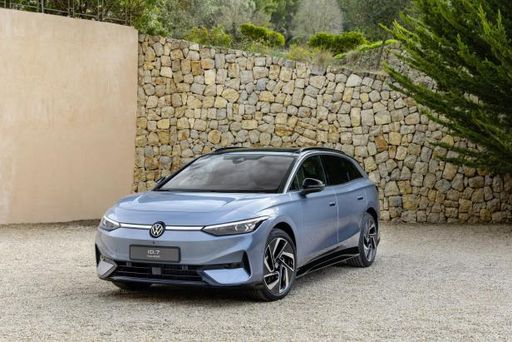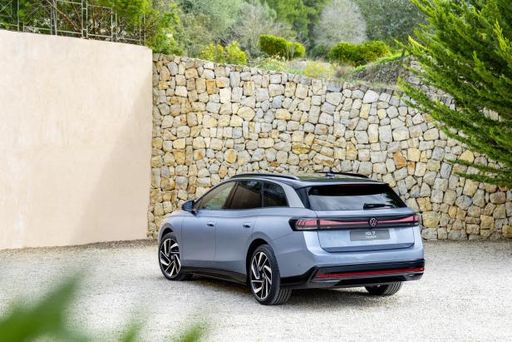Renault Trafic Bus vs VW ID.7 Touring – Differences & prices compared
Compare performance, boot space, consumption and price in one view.
Find out now: which car is the better choice for you – Renault Trafic Bus or VW ID.7 Touring?
The Renault Trafic Bus (Bus) comes with a Diesel engine and Manuel transmission. In comparison, the VW ID.7 Touring (Estate) features a Electric engine with Automatic transmission.
When it comes to boot capacity, the Renault Trafic Bus offers , while the VW ID.7 Touring provides 605 L – depending on how much space you need. If you’re looking for more power, decide whether the 150 HP of the Renault Trafic Bus or the 340 HP of the VW ID.7 Touring suits your needs better.
In terms of consumption, the values are 6.80 L per 100 km for the Renault Trafic Bus, and 14 kWh for the VW ID.7 Touring.
Price-wise, the Renault Trafic Bus starts at 38200 £, while the VW ID.7 Touring is available from 47000 £. Compare all the details and find out which model fits your lifestyle best!
Renault Trafic Bus
The Renault Trafic Bus is a versatile and spacious option for those needing to transport multiple passengers comfortably. With its modern design and practical features, it is well-suited for both business and leisure purposes. Its efficient engine and smooth handling make it a reliable choice for long journeys.
detailsVW ID.7 Touring
The VW ID.7 Touring represents a new chapter in Volkswagen's electric vehicle lineup, offering a seamless blend of style and sustainability. This estate car is designed to provide ample space and comfort for both passengers and luggage, making it ideal for long journeys. With advanced technology features and a focus on eco-friendly performance, the ID.7 Touring is set to appeal to environmentally conscious drivers who don’t want to compromise on practicality or luxury.
details @ Volkswagen
@ Volkswagen
 @ Volkswagen
@ Volkswagen
 @ Volkswagen
@ Volkswagen
 @ Volkswagen
@ Volkswagen
|
|
|
|
|
Costs and Consumption |
|
|---|---|
|
Price
38200 - 51100 £
|
Price
47000 - 54900 £
|
|
Consumption L/100km
6.8 - 7.2 L
|
Consumption L/100km
-
|
|
Consumption kWh/100km
-
|
Consumption kWh/100km
14 - 16.6 kWh
|
|
Electric Range
-
|
Electric Range
584 - 690 km
|
|
Battery Capacity
-
|
Battery Capacity
77 - 86 kWh
|
|
co2
179 - 188 g/km
|
co2
0 g/km
|
|
Fuel tank capacity
80 L
|
Fuel tank capacity
-
|
Dimensions and Body |
|
|---|---|
|
Body Type
Bus
|
Body Type
Estate
|
|
Seats
8 - 9
|
Seats
5
|
|
Doors
4
|
Doors
5
|
|
Curb weight
2031 - 2321 kg
|
Curb weight
2195 - 2339 kg
|
|
Trunk capacity
-
|
Trunk capacity
605 L
|
|
Length
5080 - 5480 mm
|
Length
4961 mm
|
|
Width
1956 mm
|
Width
1862 mm
|
|
Height
1973 - 1974 mm
|
Height
1549 - 1551 mm
|
|
Payload
749 - 982 kg
|
Payload
455 - 461 kg
|
Engine and Performance |
|
|---|---|
|
Engine Type
Diesel
|
Engine Type
Electric
|
|
Transmission
Manuel
|
Transmission
Automatic
|
|
Transmission Detail
Manual Gearbox
|
Transmission Detail
-
|
|
Drive Type
Front-Wheel Drive
|
Drive Type
Rear-Wheel Drive, All-Wheel Drive
|
|
Power HP
110 - 150 HP
|
Power HP
286 - 340 HP
|
|
Acceleration 0-100km/h
13.6 - 16.5 s
|
Acceleration 0-100km/h
5.5 - 6.7 s
|
|
Max Speed
161 - 174 km/h
|
Max Speed
180 km/h
|
|
Torque
300 - 350 Nm
|
Torque
545 - 679 Nm
|
|
Number of Cylinders
4
|
Number of Cylinders
-
|
|
Power kW
81 - 110 kW
|
Power kW
210 - 250 kW
|
|
Engine capacity
1997 cm3
|
Engine capacity
-
|
General |
|
|---|---|
|
Model Year
2023 - 2024
|
Model Year
2024
|
|
CO2 Efficiency Class
G
|
CO2 Efficiency Class
A
|
|
Brand
Renault
|
Brand
VW
|
Renault Trafic Bus
A Glimpse into the Renault Trafic Bus: An Icon of Versatility and Innovation
Amongst the plethora of vans designed for both business and leisure, the Renault Trafic Bus stands out as an exemplar of functionality, innovation, and style. Let's delve into what makes the Renault Trafic Bus a popular choice in the UK and across Europe, particularly focusing on its technical specifications and state-of-the-art features.
Performance Dynamics: Power Under the Hood
The Renault Trafic Bus, a staple in Renault's fleet, is driven by a robust diesel engine configuration with power outputs ranging from 110 PS to a formidable 170 PS. The diesel engines combine efficiency and power, offering torque figures between 300 to 380 Nm, ensuring smooth power delivery and capable load hauling.
Drivers can choose between manual and automatic transmissions, both designed to complement the Trafic's front-wheel-drive system. This flexibility ensures that drivers experience enhanced driving comfort whether they are navigating urban roads or cruising on the motorway.
Efficiency Meets Economy
The Trafic Bus showcases impressive fuel economy with consumption figures ranging from 6.8 to 7.2 litres per 100 kilometres. This efficiency is crucial for businesses aiming to minimise operational costs and for families seeking budget-friendly travel options.
With a generous fuel tank capacity of 80 litres, the Renault Trafic Bus is built to cover long distances with fewer fuel stops, making it an ideal choice for long haul journeys.
Technological Innovations and Comfort
The Trafic Bus isn't just about robust performance. Renault has integrated a suite of technological innovations designed to enhance driver and passenger comfort. Its cabins are equipped with the latest infotainment systems and safety technologies, providing an optimal blend of comfort and convenience.
The various trims, such as Life, Start, Spaceclass, and their respective EDC variants, cater to different needs and preferences, ensuring that customers can find the perfect configuration for their requirements.
Design and Dimensions: Space for Every Purpose
Space and versatility are at the heart of the Trafic Bus design. With its dimensions ranging from a length of 5080 to 5480 mm, and a width of 1956 mm, this vehicle offers ample room for passengers and cargo alike. The height stands between 1973 and 1974 mm, ensuring that even taller individuals can travel comfortably.
With seating for up to eight people and a payload capacity between 730 to 1010 kg, the Trafic Bus can transform seamlessly between a people-mover and a goods carrier.
Environmental Considerations
Renault has engineered the Trafic Bus with environmental responsibility in mind. The CO2 emissions range from 178 to 190 g/km, which, while modest for its class, aligns with the efficiency and performance goals set for this versatile vehicle. The CO2 efficiency class is rated as 'G', offering transparency in its environmental impact profile.
Conclusion: A Leader in Its Class
The Renault Trafic Bus continues to lead its segment through a blend of power, efficiency, and technological advancements. Whether it's for commercial transport or family adventures, the Trafic offers a reliable and adaptable solution, setting a high standard for multi-purpose vehicles.
For those seeking a distinguished blend of utility and comfort, the Renault Trafic Bus emerges as an exceptional choice, promising performance and innovation on every journey.
VW ID.7 Touring
Introducing the Volkswagen ID.7 Touring: The Future of Electric Estate Cars
The Volkswagen ID.7 Touring signifies a new chapter in VW's electric vehicle evolution, with a focus on combining sophisticated design and cutting-edge technology. As an estate variant of the ID series, the ID.7 Touring offers practicality and superior driving performance with a hint of luxury.
Striking Design: A Blend of Practicality and Elegance
The exterior design of the Volkswagen ID.7 Touring is both striking and functional. Measuring 4,961 mm in length, this estate car offers a spacious interior coupled with aerodynamic efficiency. The sleek lines and contemporary silhouette not only enhance its aesthetic appeal but also improve its performance by reducing drag. With a generous boot capacity of 605 litres, it provides ample space for daily use and long-distance travel.
Power and Efficiency: Driving Performance Unleashed
The ID.7 Touring is powered by a selection of electric motors, offering outputs ranging from 286 to 340 PS, catering to varying performance preferences. With a maximum torque of up to 679 Nm, acceleration is smooth and immediate, with the car achieving 0-100 km/h in as little as 5.5 seconds. The efficient electric drivetrain, coupled with a range of up to 690 km, ensures that long journeys are as enjoyable as they are efficient.
Technological Innovation: The Heart of the ID.7 Touring
At the core of the ID.7 Touring's innovative features is its state-of-the-art infotainment system, seamlessly integrated into the cabin. The intuitive interface supports connected services and advanced driver assistance systems, providing a safe and comfortable driving experience. Enhancements in battery technology allow for rapid charging, making the ID.7 Touring a practical choice for those leading busy lifestyles.
Sustainability and Costs: Electric and Economical
With zero CO2 emissions, the ID.7 Touring is a testament to Volkswagen's commitment to sustainability. The electric estate car falls into CO2 Efficiency Class A, offering an economically efficient driving solution. Operating costs are competitive, with an estimated monthly cost ranging from €1,207 to €1,382, and a cost of €0.483 - €0.553 per km, making it an attractive option for the eco-conscious consumer.
The Future of Estates: Volkswagen Leads the Way
Volkswagen's ID.7 Touring brings the electric estate car into the modern age with a perfect fusion of technology, performance, and design. As one of the most anticipated models of 2024, it sets a high bar for competitors in the electric vehicle market. With the ID.7 Touring, Volkswagen continues to lead the charge towards a sustainable automotive future without compromising style or performance.
The prices and data displayed are estimates based on German list prices and may vary by country. This information is not legally binding.
